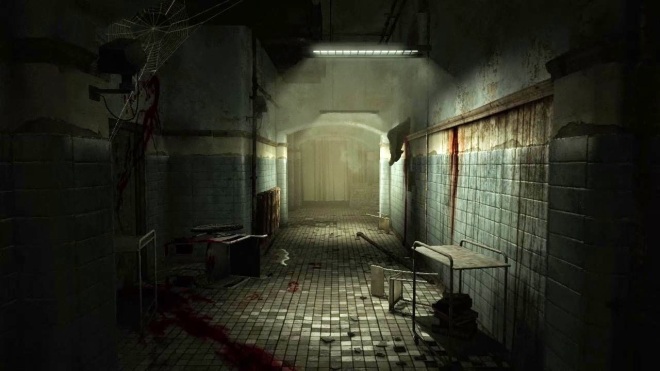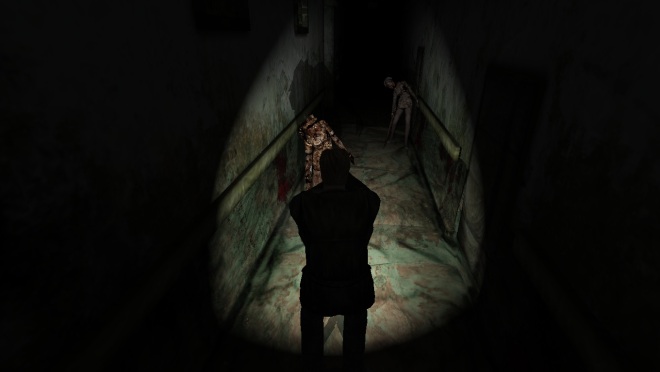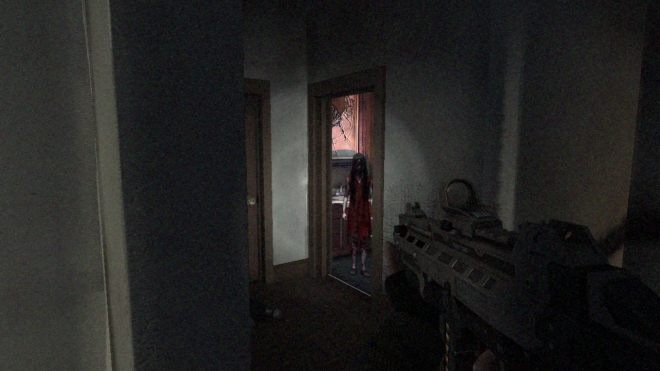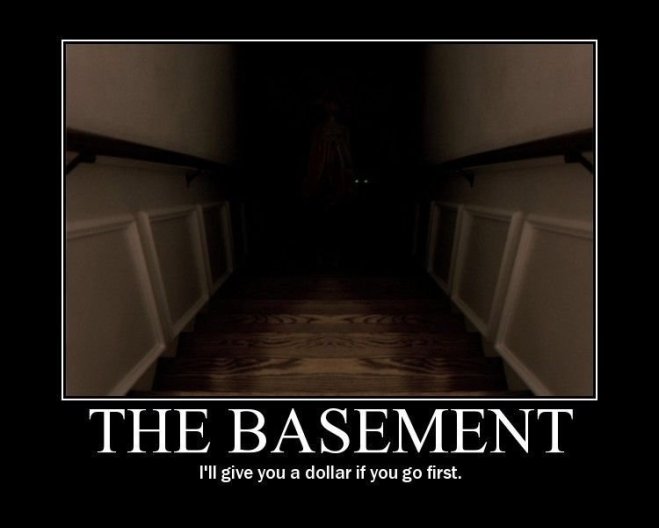A nameless character dressed in light clothes cycles through his inventory. He’s running low on pistol and shotgun ammunition and his only other source of survival lies in his survival knife to protect him from whatever lies ahead.
The next hallway is clouded in darkness, and the flashlight’s beam illuminates about six or seven feet ahead of your character.
There’s no sound, no music, and your footsteps echo as you cross the hall. Every other sense is elevated tenfold to account for your lack of visibility.
This is a hospital emergency wing on the 4th floor. The hallway is cluttered with bedsheets, overturned gurneys, and other medical supplies. A wheelchair lays on its side dead ahead, and the left wheel faces up to the ceiling as the wheel slowly grinds to an eerie halt.
A faint scream is heard down the far corridor, and suddenly you hear a squishing movement in the distance beyond the ray of your flashlight.
However whatever remains hidden away in the darkness doesn’t just want to jump out and startle you, it wants to creep around in said darkness until you’re near before it’s ready to pounce.
Naturally, your curiosity tells you to follow the sound, as your feet begin to move and your flashlight begins to draw you a path.
What you find is something far scarier than any developers can conjure up in a survival horror video game – absolutely nothing.
The squishing sound grows faint, as if whatever you were following simply vanished like a spirit. Now you’re more alert and more terrified than ever, not to mention on the edge.
The scenario I have set up for you to imagine comes an as example of atmospheric horror, a type of horror that relies heavily on its environment to produce a true feeling of dread for horror gamers.
Take for instance the Silent Hill franchise, a prime example of atmospheric horror that doesn’t use a ton of jump scares, at least from the games I have played. I have played through Silent Hill 2, almost finished 3 and have played half of 4: The Room with a little bit of Homecoming and Origins, and I can safely say that there were little to not a lot of jump scares in all of those games, but that doesn’t mean I wasn’t spooked out of my skin while playing.
Now mind you, this is going to be an opinion-based essay discussing my thoughts on both atmospheric horror vs shock horror, which is the flip side of horror that utilizes a lot of ‘jump scare’ moments to upkick your adrenaline, and maybe kick start your heart to eleven if you were starting to doze off.
I will also be referencing horror games that I have either read, researched or have played over the years. So there will be games that aren’t mentioned in this piece, and I apologize.
Now then, let’s continue.
I want to explain why I feel atmospheric horror and the imagery that is associated with this is generally a better practice for horror games than shock horror.
While I believe there are times and places for shock horror, I think that shock horror has been used more often than not clumsily to force the viewer into feeling scared.
Take for instance movies such as the remake of Friday the 13th that came out a couple of years ago, because unfortunately you couldn’t throw a rock across a pond without striking a shock stinger sound, forcing you to cower under the folds of your jacket and pray for the sweet release of death. For a movie that is based on an established franchise, you have to cut Jason Voorhees a little bit of slack, however I do feel that the amount of shock moments in that movie is absolutely ridiculous.
Better yet, a good example of a movie that utilizes shock horror terribly is 2013’s The Purge with Ethan Hawke. It basically fell into the cliché by the second half of the movie and couldn’t redeem itself following this.
Now shock horror is something more commonly found in films, less in games, but the ways we see this translated into games works in a way that is almost in tandem with atmospheric horror.
Take for instance F.E.A.R. (First Extraction Assault Recon), arguably one of the scariest FPS games of all time. I played about 3 hours of the first game, and I experienced a number of shock horror moments that came from just broken silence. Most of the early parts of the game, I remember traversing down dark hallways, being shot at by other soldiers while occasionally getting jumped by Alma, the girl on the front cover, who is a terrifying character in her own right. But the jump scares came from unexpected enemy gun fire and perhaps kicking items in the environment that would trigger a loud clanging sound, which would halt my heartbeat for mere seconds.
I think that is the perfect combination of both atmospheric horror and shock horror. However there are a lot of games I’ve played that utilize just atmospheric horror that are among some of my favorite games of all time.
I’ve always loved the Resident Evil: Outbreak spinoff series, along with the Resident Evil franchise’s early titles. Outbreak for example is a straight atmospheric horror game, relying on sounds and music to drive the mood during a scenario.
Whereas the Silent Hill series is incredibly dark, dreary, and I think a much more successful example of an atmospheric horror franchise. I find myself unable to run blindly in these games for fear that I may fall into a shock horror trap, and that’s the reason why atmospheric horror is still so important.
When you drop a character alone into a dark building with limited ammo, and an eerie silence that echoes down every corridor, there’s nothing better.
Fatal Frame II: Crimson Butterfly, in my opinion, is the scariest game that I have played to date. It is not only incredibly dark, but the environments that you traverse are incredibly dark, scary, and haunted by evil spirits. Not to mention this is set in Japan, and Japanese horror is top notch horror.
I was scrolling through forums trying to find some quotes that would describe not only my feelings on the two mediums of horror, but also share similar opinions on the two, not only on their own, but in tandem.
I found a good comment from a forum commentary named “Sniper Team 4” on Escapist Magazine, and this is what he had to say on the two:
Let me set up a real life scenario for you readers, and this is one that should definitely be relatable.
I can’t say I have a serious fear of the dark, but my mind definitely wanders in dark places. When I was living in my first house, I used to play a lot as a kid in the basement, which had an L-shaped staircase, and led down toward a hallway that would lead to a spare room, a deep freezer, shoe closet, and another backwards L-shaped hallway leading to an even bigger room where I had my consoles, a treadmill and couch and other things set up.
I always turned lights off before coming upstairs in order to conserve electricity, but by the time I turned the corner out of the larger open spaced room into the L-shaped hallway, I began to panic and would begin running up the staircase, imagining some dark creature giving chase, and eventually catching me on the staircase before dragging me back into the darkness.
This never happened, but you can’t help but suspect something resides in dark places in a house the creaks from age and changing seasonal weather patterns.
That is why when I play a game that rely heavily on its atmosphere to drive the plot and gameplay forward, I imagine my experiences running away from nothing in tight, dark spaces.
That is also why games like Silent Hill, Resident Evil and Fatal Frame are among my favorites because many of the scariest moments take place in tight corridors where claustrophobia begins to set in, and I can do nothing but run.
But I love it so much…and that’ll never change.









Leave a comment